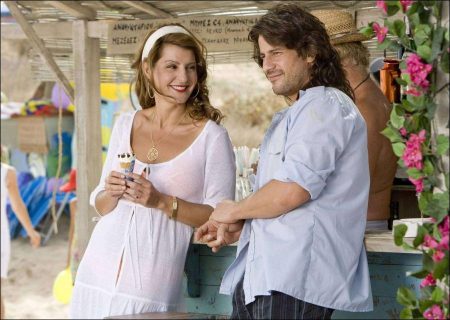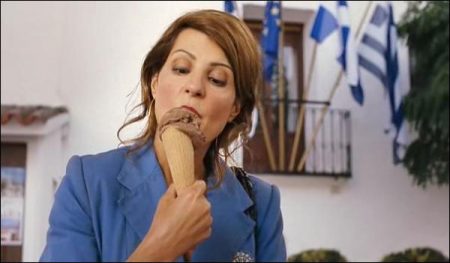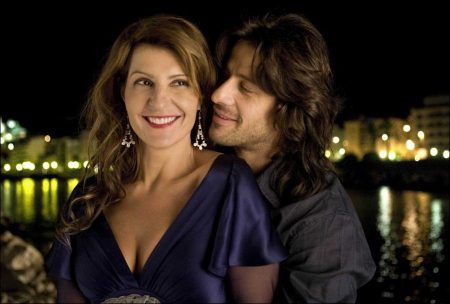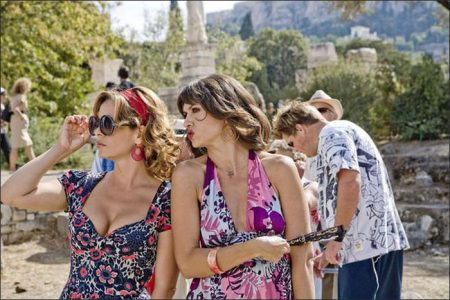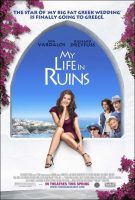All About My Life in Ruins
“I read about Olympia and Delphi and the Acropolis and all these different places, but even though I could look on a map, you never know until you get there. So I went to Greece where I fell more deeply in love with the project and Greece. And I said, ‘Yes, I think this can be done.’”
The trip also gave Petrie a chance to visualize some important moments in the story. After seeing the dramatic sites that serve as the backdrop for the film, Petrie was determined to change the location of the movie’s climactic scene. “In the original script, the bus tour begins at the Acropolis and everybody is saying, ‘Well, I’d rather have ice cream.’ I felt strongly that that was the reverse of what should happen. The Acropolis is one of the country’s highlights and it needed to be the end of the movie, after we’ve all fallen in love with Greece.”
MY LIFE IN RUINS is constructed much like a real guided tour through Greece. Consequently, much of the action is set on the tour bus or at the actual sites that travelers in Greece are likely to visit. Filming during the height of the tourist season posed a number of challenges. “One time we were shooting in the middle of the Plaka, the main square of Athens, kind of like Times Square,” says Vardalos. “In the middle of the scene, I heard some people say, ‘Hey it’s that girl from MY BIG FAT GREEK WEDDING.’ Then they walked right into the shot and kissed me on the cheeks.”
Filming among the ancient landmarks presented logistical problems as well. The film had to share the locations with real tour groups. “We couldn’t just shut down the ruins so we could shoot,” Petrie says. “A lot of times I would be walking my tour group through the ruins, carrying my sign saying Group B,” adds Vardalos. “We’d pass a real life tour group, and the guide and I would just look at each other. This one woman tour guide actually winked at me. And I thought, yeah! Tough job.”
In addition, almost every scene required all the characters on the tour to be on the set every day. “A scene might only be a page long, but it would have 20 characters in it and each had to have some time on screen,” says the director. “That can be a scheduling issue when you want to start your day and have twenty actors ready in make-up, hair and wardrobe.”
In addition, the script on the page was sometimes only a template for the larger scenes. “We went out of our way to cast actors with great improvisational skills,” says Petrie. “Oftentimes these actors had absolutely zero lines in the script that day, but I needed reactions from each one of them, and they had to be able to come up with it in character.”
The fact that the actors were improvising kept him on his toes, says the director. “I might shoot the scene from one direction and then somebody improvises something great when we were shooting the other direction. That meant I had to go back and shoot the first direction again if I wanted to include that new piece of business.”
Despite the logistical issues, Petrie knew the improvised bits would make the movie stronger and funnier. “We filmed a shopping montage with hand-held cameras in unsuspecting Greek shops,” he says. “Then we let the actors just go in character, almost like reality TV. One of our characters, Dorcas, is a kleptomaniac. She’s this little old lady, and you’d never think she would steal anything. The actress who plays her actually learned to be quite an accomplished thief. We had to go back afterward and pay for everything!”
A Busload of Acting Talent
Pulling together the large and diverse ensemble cast of MY LIFE IN RUINS required casting sessions in both Los Angeles and Europe. The requirements that the filmmakers set for themselves were exacting. They wanted a global mix of actors who had the acting ability to flesh out what might have been minor roles and the improvisational skills necessary to keep the laughs coming.
“It’s one thing when you’re putting together a cast with a guy and a girl, and they each have a best friend,” says Donald Petrie. “This was much more complicated. Originally, the script called for a group of Americans who are on this tour. That just didn’t seem like it was really how these tours happen. And I didn’t want to have two people who looked too much alike; otherwise the audience might get a little confused. So I decided to put together an international group.”
“Because Georgia sees her clients as stereotypes, I wanted to cast people who could play the stereotype, and yet evolve into a full human being by the end,” he says. “Out of the twenty roles, three are considered the leads, and the rest are all supporting characters.”
The filmmakers arrived at an amusing and appealing mix of characters – tipsy Australians, amorous newlyweds, bickering family members, on-the-prowl divorcees and clueless single guys. In the middle of all this inspired insanity is Irv, played by Richard Dreyfuss.
“Irv’s a bit of a mystery,” Petrie says. “Irv just shows up. As Georgia says, there’s always that one who thinks he’s the life of the party. He’s always cracking a joke and the jokes aren’t funny. That’s the kind of guy he is. And Georgia knows she’s going to have to put up with him for the next six days.”
But Irv becomes an almost angel-like guide who helps nudge Georgia in a better direction, in terms of her job and her love life. “Richard is perfect in the role,” says the director. “He not only has the heart, the warmth and the quirky, offbeat, funny-guy sensibility for it, but he’s the consummate actor. He’s not a comedian, which makes the character richer and more real. It all comes from his passion.”
According to Dreyfuss, “Irv is the force behind the changes in all the other characters. He’s the reason things happen and people change. Irv has Georgia figured out. He knows her secret. He’s vital in that way.”
Without anyone realizing it, Irv is pointing them all toward a fuller understanding of themselves and each other. “We call truths clichés all the time and ignore them,” says the actor. “Like ‘wisdom comes when you’re older’ or ‘life experience means something.’ Or ‘what will it be that you remember on your deathbed for real?’ Irv knows a lot of that. He’s not on a mission, but it’s part of his character to drop little breadcrumbs in front of people and let them find their way.”
“I used to tell my kids there’s a lot more going on in the world than just what you can see and touch and feel and taste,” he continues. “And Irv lives in that knowledge. He knows what magic is and about real magical love that never ends and is as real as a tree. Georgia represents going through the big magic, if you’ve got the guts. Working with Nia is like that. She brings hope, possibility and reality. The whole of Nia is far greater than the sum of the parts.”
For Vardalos, working with Dreyfuss was a highlight of the production. “It was a dream come true,” she says. “The amazing thing about my life is that I’ve gotten to work with a lot of people I admire. He was charming, funny and a consummate professional. One of my favorite moments was shooting that scene when we’re sitting on the piano bench and I thought, ‘I am having a close encounter with Richard Dreyfuss!’”
The filmmakers wanted to cast a real Greek actor to play the tour-bus driver, Poupi. Petrie was in pre-production in Los Angeles when he first saw the audition tape of Alexis Georgoulis, a popular TV star in his native Greece. “Alexis just jumped off the screen,” he remembers. “But he was one of the first ones to read, so we said ‘Yeah, he’s really good, but we’ve got to keep looking.’ But he set the bar, and even though we must have spent three months looking at other actors for this role, we finally realized we weren’t going to find anyone better than the first guy through the door.
One of the selling points for Petrie was that Georgoulis was able to be off-putting, even a little scary at first, before evolving into the handsome leading man. But for Georgoulis, who makes his American film debut in MY LIFE IN RUINS, the job required some adjustments. “It was exciting yet stressful at the same time,” he says.
It was important to Vardalos that Poupi was a real person who the audience would relate to. “Alexis was as important to this movie as getting the permits to shoot at the Acropolis,” she says. “We masked this character for the first third of the movie. We took away an important actor’s tool: his face. We needed a very experienced actor and a very deep person to pull that off.”
“Nia told me that when she saw me, she said, ‘This is the character,’” Georgoulis says. “She said the character of Poupi represents the Greek way of thinking and living. I think if you came to Greece, you would agree.”
Rachel Dratch of “Saturday Night Live” fame, who plays Kim, was excited at the opportunity to work her longtime friend Vardalos. “I auditioned for the part in New York, but there is also a little side story,” she laughs. “I knew Nia from Second City in Chicago. In fact, I was her understudy, so we’re buddies. Maybe I had a little extra going in there.”
Dratch says the film is “the total romantic fantasy where the hot foreign dude and you hook up in those beautiful locations. Anyone who’s into that—and who isn’t?—will really like this.”
Kim and her husband Big Al, played by Harland Williams, are the film’s “typical” American tourists, which gave her a chance to cut loose comedically. “Our characters are a bit like Saturday Night Live-type characters, just big, brash Americans,” says Dratch. “They’re really loud and not very aware of their surroundings. In the beginning, Kim and Al are mispronouncing everything and want it all to be ‘the American way.’ It’s a huge stereotype, but we saw people like that everywhere in Greece.”
“At the end, we’re learning to say the names of the Greek food correctly and to speak a little bit of the language. We’ve dropped our USA gear and we have some Greek clothing on.” According to Dratch, Vardalos is as warm and enthusiastic in real life as she appears on the screen. “She’s the tour leader in the movie, but she’s the group leader in real life. She’s very positive. She never seems to be grumpy or tired, so it’s fun to have her involved.”
Given the ensemble nature of the script, Dratch thought the production would essentially be a European holiday—but she quickly learned that was not the case. “When I saw the amount of lines I had, I thought, I’ll be in it here and there,” she says. “But then when I got there, I found out I was working every single day. We’re always in the background. There were so many times our backs were to the camera that we came up with the term ‘backting.’ That was our big time to shine, so we needed to emote just from our backs. I’ve done a lot of backting in this movie.”
Seven seasons on “Saturday Night Live” may have prepared her for the kind of controlled chaos that comedy improv can create, but her acting partner Harland Williams was still able to surprise her. “I never knew what he was going to say. Sometimes he’d throw in some weird thing that wasn’t in the script and it was hard for me to stay in character. He’s an odd, odd duck and a unique comedian.” Anyone who has spent a few minutes talking to Williams knows what she means. When asked how he got involved with this movie, Williams kiddingly replies, “There’s a term they use in Hollywood—the ‘casting couch.’ I was brought in first by the producers, pretty much seduced, used and shuffled out the door.”
Williams loved working with Dratch. “We make a good couple because I’m about nine feet tall and I think she’s part Smurf. And, of course, she’s got great comedic timing and she’s just hilarious.” About the only thing he is willing to be serious about is his admiration for Richard Dreyfuss. “The prospect of working with Richard made me really want to do this film,” he says. “I love his work and to work around someone like that was what I really wanted to do.”
Playing Georgia’s underhanded and sneaky co-worker Nico, Alistair McGowan is well known in his native Britain for his spot-on impressions of entertainers, sports figures and politicians. McGowan approached Nico’s Greek dialect with characteristic aplomb. “I think of accents as grooves within a ploughed field of asparagus, because I come from asparagus country,” he notes. “The voices lie in the grooves of these beds and once you’ve finally got a voice into that groove, you’ve got it.
“There are certain sounds in Greek that are unique. You have to get those sounds. My girlfriend got me a recording of somebody teaching people to speak Greek. I owe this guy, wherever he is, a huge debt. Alexis, too. I talked to him a lot early on to get a sense of the accent.”
Although McGowan has appeared on dozens of TV movies, specials and series over the past 25 years, MY LIFE IN RUINS is his first feature film. “Donald is terrific to work with,” he says of the director. “He knows what he wants, but at the same time he’ll take input from the actor. When I first met him, he asked if I was okay improvising, which is right up my alley. A lot of the actors involved in this have a history of improvising or writing so that they’re quite at ease with that.
“And of course, Nia’s very warm. She puts you at ease straightaway. She has no airs, so she made it very easy.”
McGowan calls the film “very well observed. There is a kernel of truth to all the stereotypes. I was at the Acropolis, enjoying the most fabulous view you could ever imagine. And there was a man next to me who said, “There’s not much to look at that way.” What? All of Greece was over there! The sea! There’s history! Everything you could possibly want to feel about life and about history was right there!” The actor invokes the Greek philosopher Socrates when he describes the film. “He believed that the best journey you can go on in life is a journey within yourself. And in this film, the characters all do. Too many people go to these spectacular places and take nothing away except a bunch of photographs. I think you should absorb things and just let it go in there. It’s not about simply being there. It’s about finding something deeper. Bottom line, this film has good gags, good characters and a real human situation.”
The rest of the seats on the tour bus are also filled with familiar performers. Caroline Goodall, Ian Ogilvy and Sophie Stuckey play the Tullens: an imperious doctor, her henpecked husband and their sullen teenage daughter. Goodall describes herself as a huge fan of Vardalos’ first film. “Knowing Nia was going to be involved really energized me to want to be a part of this,” she says. “And it’s a marvelous character—she is a species of glorious monster, someone who is addicted to being right.”
Ian Ogilvy says of his character, “He’s the simplest member of the family. He ‘s married to a rather difficult woman and they have a sulky teenage daughter and none of us are quite sure why we’re on this trip.”
Ogilvy got involved with the film when he received an email from Petrie asking if he would be interested. “We talked about the movie a little bit, it was as easy as that.” says Ogilvy. “It’s a feel-good movie.”
Simon Gleeson and Natalie O’Donnell play Ken and Sue, the Australians. Husband and wife in the film, they are married offscreen as well. “We joked with Donald that this could be the end of our marriage,” says Gleeson, but the prospect of working with Petrie and Vardalos, plus the opportunity to visit Spain and Greece, were too good to turn down. “To have carte blanche access to Delphi and Olympia was irresistible. I think the whole cast felt the same way.”
“The way Nia captures the characters, the romance and the comedy give this the movie same spirit as MY BIG FAT GREEK WEDDING,” says O’Donnell. “And the caliber of people attached to the film is amazing. When I heard there would be 20 of us and that we were all going to be with each other all day, I was worried, but the camaraderie has been outstanding.”
Sexy Spanish leading ladies María Botto and María Ádanez play Lala and Lena, both recently divorced and joined at the hip in their search for a new romantic partner. The “two Marias” as they became known on the set, had previously worked together in Spain, but this was the first Hollywood movie for both. “When I heard it was going be a film with Nia Vardalos, directed by Donald Petrie, I knew it would be great,” says Ádanez.
Sheila Bernette and Ralph Nossek play Dorcas and Barnaby, a charming elderly English couple. A veteran of the British Music Hall tradition, Sheila tactfully describes her character as “very thoughtful, very nice, and very old. And a little crazy. She does collect things from shops without paying.” The film’s dream locations hooked Bernette. “It has been such a wonderful experience to be in Spain and Greece, with a lovely cast and everyone is so nice. People pay a lot of money to go the places we’ve been and by God, they were stunning.”
Nossek says working with Vardalos, Petrie and the rest of the cast was “marvelous. The Americans talk an awful lot, but they’re all very entertaining, I love them.”
Some of the film’s most outrageous moments involve the character of Gator, a naïve college student in Europe for the first time. Nineteen-year-old actor Jareb Dauplaise says, “I did not have to dig super, super deep for Gator. He’s all about living in the moment. He wants to see the world; he wants to experience everything he can at this point.”
Along with three Russian ladies who speak not a word of English, Brian Palermo rounds out the roster of passengers as Marc, an IHOP sales rep who can’t see the forest for his Blackberry. “Marc appears to be a normal guy until you get into a conversation with him,” says the actor. “The International House of Pancakes is his entire life. He thinks it’s the most interesting thing in the world and drones on and on about pancakes and syrup and things.”
“The big cast was so much fun. Hearing all the different accents everyday was been great.” says Palermo. “And Donald was so patient. He had 20 ensemble cast members and an international crew. Just to try and organize that is intimidating.”
And if audiences look closely, they’ll get a glimpse of Vardalos’ personal good luck charms. “My parents, Gus and Doreen, are in the movie. They’re in the scene at the Souvlaki stand where I realize that Poupi speaks English and I’ve just told him how long it’s been since I’ve had sex. Then I ask the people online, ‘Does anyone else speak English?’ and everyone raises their hands. My mom and dad are in the middle of the line giving me a dirty look.”
A Pangloss Tour of Greece
Discovering the script for MY LIFE IN RUINS exploded Donald Petrie’s long held theory about films that shoot on location. “Usually I find that the quality of script and desirability of locale are in inverse relationship,” he explains. “If the film starts off in the south of France on a sun-drenched beach with beautiful women strewn all over the sand, it’ll be the worst script I’ve ever read. And if it takes place in Minnesota in winter I will love it.”
“So I read the script and I went, ‘Ooh, I really like this script. Do I just like it because it takes place in Greece, or do I really like this script?’ I had to divorce myself from the locale and I found that I still loved the script.”
MY LIFE IN RUINS was shot on some of the most spectacular and famous historical sites in Greece, including the Acropolis, the center of ancient Athens. In fact, MY LIFE IN RUINS made history as the first movie ever to film there. While many filmmakers previously sought permission to shoot on the revered spot, the Greek government had never granted that privilege to anyone. Vardalos spent the better part of a year wooing the Hellenic Government for the privilege of being able to shoot at the Acropolis and several other of the world’s most historically significant landmarks.
“I had a lot of dinners and did a lot of handshaking,” says Vardalos. “I have to credit my parents for making me go to Greek school, because after all those years I’m fluent in the language. I flew there about a year before and met with everyone I could. I had a personal relationship with the Minister of Culture because of the first Greek movie and she was extremely instrumental. I also assured the government we would leave the ruins exactly as we found them.”
Vardalos sees the movie as a celebration of Greece. “I am still in awe when I consider where we were able to go. We were so lucky. It’s a majestic experience to be at these places.”
The first important monument the tour group visits is Olympia, the site of the original Olympics in the 8th century B.C. “The settings actually evolve the same way Georgia’s character does,” explains Petrie. “In Olympia, the place that people were tested for their prowess in sports, her character is tested on how she can perform as a tour guide. Can she become better? Can she somehow be both entertaining and educational?”
The next major stop is Delphi, the site of an ancient temple dedicated to the god Apollo. Delphi was once one of the most important religious destinations in existence. Visitors from all over Greece and other parts of the Hellenic world came to Delphi to consult the Oracle, whose cryptic advice could determine the course of history.
“Delphi is a mysterious place known both for the Oracle and for its healing powers,” says Petrie. “It has a kind of a healing power over our group and finally brings them together as one.” Finally, the tour group reaches the Acropolis. The Acropolis is the nucleus of Athens, the original citadel built at the highest point of the city proper. The most celebrated site in Greece, it sits atop the layers of history that have created the modern Hellenic state.
“At the Acropolis, our group has finally come together as a unit,” says Petrie. “Each one of the characters has had their own emotional arc that relates to the site. And as a group, they are now ready for the final test, because one of them has fallen ill and is in the hospital.”
“Donald chose locations that were beyond my wildest imagination,” says Vardalos. “He did an amazing job visualizing the scenes. That’s what you want a director to do, take words and then turn them into pictures.”
In addition to its incomparable history, Greece is rich in natural beauty, something that the cast was able to appreciate, even with the hectic shooting schedule. “If I was on a normal movie set and I was waiting around, I’d probably be sitting in my trailer doing whatever,” says Rachel Dratch. “With all those amazing mountains and ruins around us, I just sort of wandered around. Even though we didn’t get a lot of free time, we were in the midst of it, and we got to take it in.”
Dratch, an avid traveler, hopes anyone unable to get to Greece will enjoy the scenery and the culture vicariously. “It’s like a fantasy vacation where you get to see what Greece is like for the price of a movie ticket.”
Alistair McGowan, who traveled overland from the United Kingdom and reached Greece by ferry, says he understands the pride Greeks have in their country. “Arriving on a boat from Italy was extraordinary,” he says. “You feel as if the country is opening up to you. Greece brings out changes in people. You start to open yourself up to other people. Learn about others and about yourself. It’s enriching, and that happens throughout the film.”
“Part romantic comedy, part tale of self-discovery, part travelogue, MY LIFE IN RUINS is a journey many people will enjoy,” says director Donald Petrie.
Over his long film career, Petrie has learned that trying to predict what kind of an audience a movie will attract is essentially impossible. “When I made GRUMPY OLD MEN, the marketing department thought it would appeal only to octogenarians. But I had kids coming up to me all the time to tell me how much they loved it. It hit all quadrants. I hope this movie does the same thing. It is different and entertaining. It will make you laugh and make you cry. Who’s not going to want to see it?”
My Life in Ruins (2009)
Directed by: Donald Petrie
Starring: Nia Vardalos, Richard Dreyfuss, Harland Williams, Rachel Dratch, Caroline Goodall, Ian Ogilvy, Sophie Stuckey, María Botto, María Adánez, Brian Palermo, Natalie O’Donnell
Screenplay by: Mike Reiss
Production Design by: David Chapman
Cinematography by: José Luis Alcaine
Film Editing by: Patrick J. Don Vito
Costume Design by: Lala Huete, Lena Mossum
Set Decoration by: Sonia Aranzabal, Christine Vlachos
Art Direction by: Jonathan McKinstry
Music by: David Newman
MPAA Rating: PG-13 for sexual content.
Distributed by: Fox Searchlight Pictures
Release Date: June 5, 2009
Visits: 86
